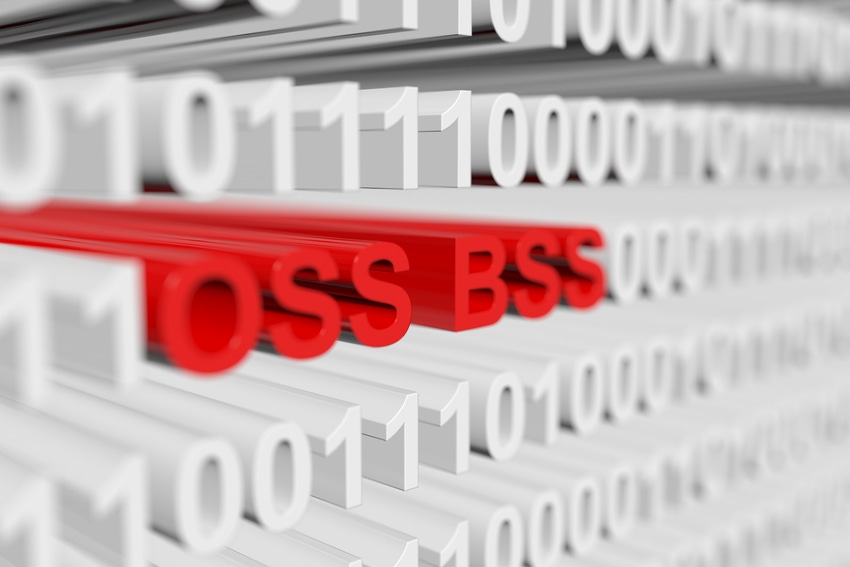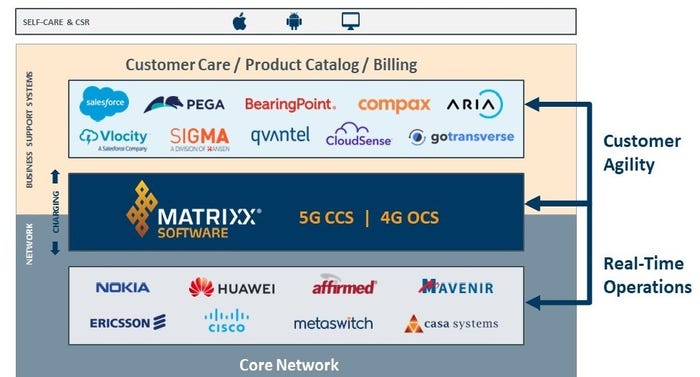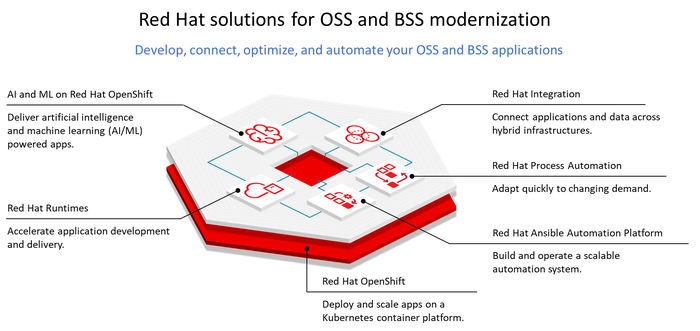December 2, 2020

By Dr. Mark H Mortensen, Principal Analyst, ACG Research
This article is sponsored by Red Hat and Intel
Operations support systems (OSS) and business support systems (BSS) are being rewritten or refactored to cloud-native, microservices-based applications capable of running on hybrid cloud and multicloud computing and storage infrastructure. MATRIXX Software was created to take advantage of the inherent advantages of cloud-native software for 5G and other monetization needs. The MATRIXX Digital Commerce Platform, optimized to provide the business agility needed for 5G and other new digital services, runs on the Red Hat OpenShift container platform deployable solution architecture that optimally executes on carrier-grade Intel computing and storage technology.
Introduction
This article provides a summary of the webinar, jointly sponsored by Red Hat and Intel, “Building a Real-Time, Cloud Native Charging Platform Tailored for 5G”. We describe the current movement of OSS/BSS to cloud-native technology running on a hybrid cloud infrastructure and describe how one leading vendor, MATRIXX Software, differentiates its offering by using Red Hat software. This software, applied to BSS, OSS, and containerized network functions (CNFs) runs optimally on Communication Service Providers’ (CSP) tuned computing and storage technology by Intel.
OSS/BSS in the Clouds
Cloud-native software technology is being driven by the open-source community. It was originally created by the web-scale players for their own use utilizing modern Service Oriented Architecture (SOA), DevOps development methodology, and Continuous Integration/Continuous Deployment (CI/CD) implementation techniques. These techniques are embodied in tool sets that they released to the open-source community and represent the current state of the art in software development. Vendors and CSPs have been executing programs with these technologies and have proved them out for telecommunications use cases. They are now quickly moving OSS and BSS systems to the cloud through a combination of re-coding and refactoring.
My Take: Now that it has been proven, cloud-native software is being rapidly deployed in the telecoms industry as CSPs become digital service providers. The adoption of 5G cores that are intrinsically cloud native matches the flexibility and scalability of the cloud-native BSS and OSS systems is driving this even faster. ACG Research estimates that, today, about 30% of newly deployed OSS and BSS are cloud based. By 2025, that figure will rise to 90%, and most CSPs will have plans for the eventual phase-out of noncloud-based OSS/BSS.
MATRIXX Digital Commerce Platform: A Fully Cloud Native Monetization Solution for CSPs
MATRIXX Software exploits the new cloud software technologies to create a disruptive, remarkably agile system with the ability to launch and modify novel services in a matter of weeks. As the MATRIXX Digital Commerce Platform evolved into a full cloud-native architecture, it picked up the capabilities of cloud- native software such as seamlessly automating the scale-out and scale-up of real-time rating and charging, a critical requirement for 5G and other emerging digital services. Beyond that, cloud-native software provides the key flexibilities of MATRIXX, including scalability, an API first mentality, the ability to support low-latency applications, and the delivery and evolution of all these benefits via a continuous pipeline of innovation.
Scalability
Automatic scaling of the charging function by bringing new instantiations of the applicable microservices online.
API First
With the charging function so critical not only for the DSP itself, but also for third-party offerings, the availability of an open API to the partners greatly speeds implementation of changes to the pricing values and models.
Latency
With data rates so high, latency in the charging platform can lead to poor implementation of data caps. The cloud-native nature allows the charging functionality to be optimally deployed centrally or at the edge, as well as fluidly in public, private, and hybrid clouds. Real-time rating and charging at the scale of 5G dictates a maniacal focus on transactional latency.
Continuous Innovation
With the use of DevOps development processes, where a small team works on a microservice from conception to deployment (and beyond), and the use of CI/CD automated testing and delivery, MATRIXX’s time from planning to delivery of new capabilities was significantly reduced.
These characteristics are critical not only for the business agility of the system itself, but to be a good citizen in an overall ecosystem of specialized systems in the DSPs’ operations (Figure 2). Full-function, stable APIs are required, while being able to innovate within the system, providing new functionality as the CSPs’ requirements change as they move to become full-fledged DSPs.
MATRIXX described how its move into cloud-native software was greatly helped by its use of Red Hat OpenShift in all its deployments.

Figure 1. MATRIXX Software Ecosystem (Source: MATRIXX, 2020)
My Take: The MATRIXX Software Digital Commerce Platform is a proven, high-performance rating and charging solution for DSPs that maximally incorporates the best of the new cloud-native software architecture and takes advantage of current technologies and positions it for future cloud technologies. Its use of the proven Red Hat open source, especially Red Hat OpenShift, provides an inherent stable and automatically scalable base for its software offerings, especially in the real-time charging arena.
Red Hat OSS/BSS Modernization Solutions
For service providers, OSS and BSS are fundamental and crucial to innovate and compete in quickly changing markets. It’s no longer only about billing and operating three or four core services. Now operators are competing in a platform-based economy where innovation is created through partners’ ecosystems As digital service providers seek competitive advantage, they need an open and consistent OSS/BSS foundation to build differentiated services with speed, open to an ecosystem that maximizes choice. Red Hat helps service providers build and run cloud-native OSS/BSS solutions on premise and on any cloud with higher efficiency and flexibility.

My Take: Red Hat OpenShift represents a major advance in hybrid cloud/multi-cloud software development and deployment. The other components of the Red Hat OSS and BSS technology modernization portfolio are proven, especially Red Hat Integration and Red Hat Automation products, including the Red Hat Ansible Automation Platform. Red Hat is a major player in the move of OSS, BSS, and NFV software to the cloud.
Figure 2. Red Hat OSS/BSS Modernization Solutions (Source: Red Hat, 2020)
Intel Cloud-Native Hybrid-Multicloud with NFV Reference Architecture
Although creating cloud native solutions can be a challenging task, Intel has a history of rising to support similar industry transitions and has already invested in 5G cloudification and network transformation efforts in partnership with Red Hat. Intel was the founder and lead contributor to the Data Plane Development Kit, which just experienced its 10-year publishing anniversary, making NFV adoption by CSPs possible. Most recently, Red Hat and Intel released a new Reference Implementation, optimized for cloud-native hybrid/multicloud and built using Red Hat OpenShift Container Platform. It is designed to let CSPs and the industry ecosystem quickly turn innovations into deployed VNFs/CNFs and transform OSS/BSS systems. This investment in thoroughly verified reference configurations provides a scalable, cost-efficient foundation to achieve deterministic performance for most demanding use cases as well as to lower design and integration risks.
My Take: Intel has been putting significant effort into working with its NFV technology partners for several years, including Red Hat. The Intel platforms represent a strong optimized hardware base for high-performance telco cloud deployments.
Conclusion
The movement of CSPs’ OSS and BSS systems to the cloud and cloud-native technology is underway, helped strongly by companies such as Red Hat and Intel. MATRIXX Software has used these platforms in its applications to provide a strong, scalable system that can serve as a platform for today’s and tomorrow’s monetization applications. Especially difficult is the real-time charging function, which can benefit greatly from the ability of the cloud platform, powered by Red Hat technology, to automatically scale to provide excellent real-time performance. The time is now for digital service providers to transition to cloud-native OSS and BSS solutions to stay competitive, innovate, and meet increasing customers’ expectations.
Read more about:
Vendor SpotlightsYou May Also Like






.png?width=300&auto=webp&quality=80&disable=upscale)


_1.jpg?width=300&auto=webp&quality=80&disable=upscale)


.png?width=800&auto=webp&quality=80&disable=upscale)